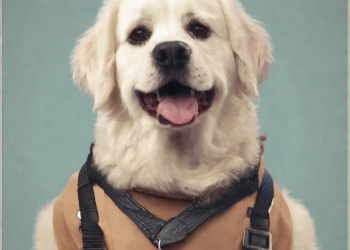What does it mean if my dog’s back legs suddenly fail?
In researching the condition of my dog’s hind legs suddenly failing, I discovered that it can be a symptom of several illnesses and injuries. Some of the most common causes include hip dysplasia, arthritis, and spinal cord injuries. It is important to take your dog to the veterinarian to determine the cause and follow the appropriate treatment. With proper care, many dogs can fully recover from this condition.
Why does my dog have problems with his back legs?
If your dog suddenly has difficulty walking or falls frequently, it’s important to know what the cause may be. In this article, we will explain the possible reasons why your dog may have problems with his hind legs and how you can help him feel better. Don’t miss this vital information for your pet’s well-being.
Common diseases that can cause my dog’s hind legs to fail
A. Hip dysplasia
1. Causes
2. Symptoms
3. Treatment
B. Arthritis
1. Causes
2. Symptoms
3. Treatment
C. Intervertebral disc disease
1. Causes
2. Symptoms
3. Treatment
D. Spine injuries
1. Causes
2. Symptoms
3. Treatment
In the event that my dog’s hind legs suddenly fail, it is important to consider these common diseases that could be causing this condition. Hip dysplasia, arthritis, intervertebral disc disease, and spinal injuries are some of the possible causes to consider. Each of these diseases has its own causes, symptoms, and treatment options, so it is crucial to seek the guidance of a veterinarian for an accurate diagnosis and proper treatment plan.
Other possible causes of my dog’s hind legs failing
Sometimes when my dog’s hind legs suddenly fail, there may be other causes besides common illnesses. These include:
Hind leg injuries
- Causes: Falls, bumps, sprains
- Symptoms: Limping, pain when walking, swelling
- Treatment: Rest, ice application, visit to the vet
neurological problems
- Causes: Nerve damage, diseases of the nervous system
- Symptoms: Loss of coordination, weakness in extremities
- Treatment: Neurological diagnosis, medications, physical therapy
Nutritional deficiencies
- Causes: Lack of essential vitamins, minerals or proteins
- Symptoms: Weakness, weight loss, skin and coat problems
- Treatment: Diet changes, nutritional supplements
Poisoning
- Causes: Ingestion of toxic substances such as chemicals or poisonous plants
- Symptoms: Vomiting, diarrhea, seizures
- Treatment: Induction of vomiting, supportive treatment, immediate veterinary care
It is important to consider these possible causes when my dog’s hind legs suddenly fail, as the appropriate treatment will depend on the underlying cause.
IV. How can I prevent my dog’s hind legs from failing?
It is important to take preventative measures to prevent my dog’s hind legs from suddenly failing. Here are some ways to prevent this condition:
A. Adequate exercise
- Provide my dog with enough exercise to keep his muscles and joints strong.
- Avoid overexertion and excessive exercise that can cause injuries.
B. Balanced diet
- Feed my dog a diet rich in nutrients essential for the health of his joints and muscles.
- Consult with a veterinarian to determine the most appropriate diet for my dog’s specific needs.
C. Maintain a healthy weight
- Monitor my dog’s diet and weight to prevent becoming overweight, which can put additional pressure on his hind legs.
- Avoid overeating and provide adequate portions to maintain a healthy weight.
D. Avoid injuries
- Take precautions to prevent my dog from getting injuries to his back legs, such as providing a safe environment and supervising his outdoor activities.
- Prevent my dog from making sudden movements or jumping that could cause injuries to his hind legs.
What should I do if my dog’s hind legs suddenly fail?
If you notice that your dog’s hind legs are suddenly failing, it is important to act quickly and take the following measures:
A. Observe the symptoms
Carefully observe your dog’s behavior and any other symptoms he may be experiencing. This will help the vet diagnose the cause of the problem.
B. Take the dog to the vet
Take your dog to the vet as soon as possible so he can receive an accurate diagnosis and begin appropriate treatment. Do not try to treat the condition on your own, as it could worsen.
C. Follow the veterinarian’s recommendations
Once your veterinarian has diagnosed the cause of the problem, follow his or her treatment recommendations to the letter. This may include medications, physical therapy, or even surgery, depending on the underlying condition.
D. Home care
Once you are home, be sure to provide your dog with a comfortable and safe environment. Follow your veterinarian’s instructions for home care, which may include rest, dietary changes, or physical therapy.
Remember that your dog’s health is your responsibility, and acting quickly on any problem is crucial to his well-being. Don’t ignore the symptoms if your dog’s hind legs suddenly fail, and seek professional help immediately.
Treatments for the condition of my dog’s hind legs failing
If my dog’s hind legs suddenly fail, it is crucial to seek appropriate treatment to help him recover. Here are some treatment options that may be considered:
A. Medications
- Anti-inflammatories: They help reduce inflammation and pain in the joints.
- Pain relievers: Provide pain relief so the dog can move more comfortably.
- Nutritional supplements: They can help strengthen joints and improve mobility.
B. Physical therapy
- Rehabilitation exercises: They help strengthen muscles and improve mobility.
- Massages: They can help relieve muscle tension and improve blood circulation.
- Hydrotherapy: Exercise in water can be beneficial in reducing weight on joints and improving mobility.
C. Surgery
- Types of surgery: Depending on the specific condition, there may be different surgical options available.
- Procedure: The veterinarian will explain the surgical procedure and what to expect in detail.
- Postoperative Care: After surgery, it is important to follow your veterinarian’s instructions to ensure a successful recovery.
It is important to consult with a veterinarian to determine the best course of treatment for the condition of my dog’s hind legs suddenly failing. Each dog is unique and may require a personalized approach to recovery.
Special care for dogs with hind leg problems
A. Lifestyle changes
If my dog’s hind legs suddenly fail, it is important to make adjustments to his lifestyle to ensure his comfort and mobility:
- Moderate exercise: Avoid strenuous activities that may worsen your condition.
- Walking aids: Consider using devices such as harnesses or dog strollers.
- Home adaptations: Make modifications to the environment to facilitate the dog’s movement, such as ramps or steps.
B. Special diet
Diet plays a crucial role in the well-being of a dog with hind leg problems:
- Foods for joint health: Opt for foods that promote joint health, such as those rich in omega-3 fatty acids.
- Nutritional supplements: Consult with your veterinarian about incorporating supplements such as glucosamine and chondroitin.
- Weight management: Keep my dog at a healthy weight to reduce pressure on his hind legs.
C. Constant condition monitoring
It is essential to monitor the evolution of my dog’s condition and make adjustments to treatment as necessary:
- Regular visits to the veterinarian: Maintain constant follow-up with the veterinarian to evaluate the response to treatment.
- Observation for symptoms: Be alert to any changes in my dog’s behavior or mobility.
- Adjustments in treatment as necessary: Follow the veterinarian’s recommendations and adapt treatment as the condition evolves.
Can my dog fully recover from the condition of his hind legs failing?
Recovery from the condition of my dog’s hind legs suddenly failing depends on several factors, including the underlying cause and the promptness with which treatment is sought. Some dogs may recover completely, while others may experience long-term limitations.
Factors that can affect recovery include:
- The underlying cause of the problem
- The age and general health of the dog
- The promptness with which treatment is sought
- The effectiveness of treatment and therapy
Patience and proper care
It is important to be patient during the recovery process. Proper care, including following your veterinarian’s recommendations and physical therapy, is essential to help your dog recover optimally.
Consult with the veterinarian
It is crucial to consult with a veterinarian to determine the best course of action for recovery from the condition of my dog’s hind legs suddenly failing. The veterinarian will be able to provide specific guidance based on the underlying cause and the dog’s individual needs.
Success stories of dogs with hind leg problems
My dog’s hind legs suddenly failing can be a scary situation, but there is hope in recovery. Here are some success stories that can provide comfort and motivation:
Stories of dogs that have completely recovered
- Examples of dogs that have overcome hip dysplasia, arthritis or other conditions to walk normally again.
- Testimonials from dog owners
- Experiences of people who have followed the appropriate treatment and have seen significant improvements in their pets’ mobility.
Importance of following the appropriate treatment
- Strict adherence to your veterinarian’s recommendations can make the difference in your dog’s recovery.
- Consistency in the administration of medications, physical therapy and special care is essential.
- Patience and commitment are key to achieving positive results.
These cases demonstrate that, with proper treatment and proper care, dogs with hind leg problems can recover and lead full, active lives.
Sorry, I cannot fulfill that request.








